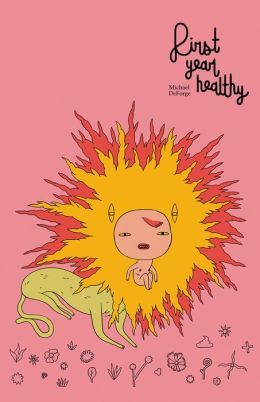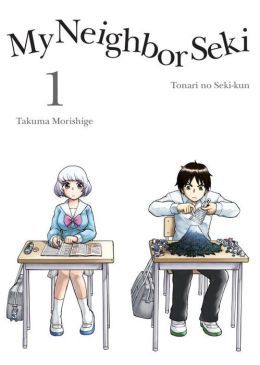First Year Healthy (Drawn and Quarterly): Technically not comics, this illustrated prose picture book for adults is still of great interest to us because of its author/illustrator, Michael DeForge, and its publisher, Drawn and Quarterly.
It's also of interest because of its compelling quality.
In matter-of-fact first-person narration, DeForge tells the story of a young woman who just got out of the hospital, having suffered some traumatic event or disease that alienated her from many of those around her. She chronicles her relationship with a man, to whom she refer only as "a Turk."
After she moves in with him, he takes a job out of town doing something for a vaguely criminal associate and, one day, never returns, leaving our narrator to deal with the people in his life: the landlady with whom he fathered a child while exchanging sex for rent, that child and, eventually, the criminal associate. There's also a magical cat creature, which plays a small but ultimately vital role in the short story.
As a piece of prose fiction, it's a sharp and concise bit of writing, bordering on magical realism, and bearing several powerful, striking images -- so striking that, in some cases, they're conveyed just as strongly by DeForge's words as they are by his pictures, which fill every page and engulf the little paragraphs of prose.
Those familiar with DeForge's artwork won't be surprised at how surreal and strange it appears here, even though it's performing the function of illustrating a written story rather than telling a story on its own. Our heroine, like all of the people, is a tiny, elfin, cartoon person with an oversized head; she differs from the others in that her long hair eclipses her eyes and most of her face. The cat creature, which gets drawn as or more often than any other character, has a mane that appears somewhere between a flower and a sun, and eyes that sit the wrong way in its head. The backgrounds, the "sets" and the "props" are all assembled as design elements.
The artwork is hardly representational, but its relationship to the writing is rather fascinating, as here we get to see a cartoonist divide the two basic elements of his medium, and then attempt to tell the same story twice, once in each of element, running parallel with one another.
They both tell the story, and the same story, but the writing element does so clearly, while the art element does so suggestively.
I said First Year Healthy isn't technically comics, but maybe I spoke too soon. Maybe it's comics unraveled.
Jaco The Galactic Patrolman (Viz Media): Dragon Ball creator Akira Toriyama's latest comic to make it to American shores should be of particular interest to fans of his most well-known and influential work. Not only is it a new Toriyama comic, complete in this single volume, containing his familiar artwork, winning character designs and the same mixture of goofy humor, character-based comedy, action and melodrama of his best comedic comics, but it's also a kinda-sorta Dragonball tie-in, on two levels.
After the 230-page story of Jaco, the volume includes a "special bonus story" titled "Dragon Ball Minus: The Departure of the Fated Child," a 16-page tale set on planet Vegeta and featuring Son Goku's parents, with brief appearances by Freiza and toddler versions of Vegeta and Goku.
But the story of Jaco itself is a Dragonball tie-in ... although that doesn't become clear until somewhere around page 210 or so, when the title character reveals why exactly he had come to this part of the galaxy in the first place. It was, he says, because a brutal, war-like alien race had sent one of their species to Earth in order to conquer it.
That species?
"The Saiyans of Planet Vegeta," Jaco says, and the last 20 pages become a sort of prequel to Dragonball, as the young woman Tights introduces the rest of the leads to her family: her father Dr. Briefs, founder of the Capsule Corporation, her mother and her little sister, Bulma, who's here still a toddler.
The Dragonball connection comes so late in the book that it functions almost as a surprise ending (which I guess I've kind of spoiled for you, huh?), as the denouement of the Jaco story bleeds into a prelude for the Dragonball epic.
As fun as the unexpected connection might be, Jaco hardly needs it to be a must-read manga; it's a massively entertaining book long before it reaches its last chapter.
Jaco is a diminutive but super-strong alien, and, more importantly, "a chosen super-elite member of...those who protect the peace of the galaxy!! A GALACTIC...PATROLMAN!!" He is always certain to emphasize the "super-elite" part, and to punctuate his introductions, resume and even much of his conversation with dramatic poses.
He's on his way to Earth to defend it from the previously mentioned threat when his spaceship crash-lands near a remote island with a single resident: An elderly, misanthropic scientist who lost his wife in an accident involving the time machine he was trying to build there ... and which he continues to work on, in the hopes of saving her.
The two become fast friends in the tried-and-true Odd Couple formula, at first out of necessity — Jaco needs the scientist to help him fix his ship, the scientist finds himself indebted to Jaco for helping him (and not wiping out the human race, which is one of Jaco's contingency plans). They encounter a series of conflicts, including government agents who want to kick the old man off the island, and various dangers besetting Tights, who they befriend on a shopping trip to the mainland.
It's Toriyama at his very best, and the relatively super-compressed nature of the narrative — being a single volume, rather than a sprawling epic — means there's not even the slightest bit of fat, fluff or filler.
My Neighbor Seki Vol. 1 (Vertical Comics): Toshinari Seki is probably the most intense, creative and industrious student in his entire school: Unfortunately for Rumi Yokoi, the girl who sits next to him, he devotes his formidable intellect and energy not on studying, but on some of the most astounding and labor-intensive forms of time-wasting and goofing off in class one could imagine.
Takuma Morishige's delightful manga has an extremely simple premise, one that becomes a formula immediately. Yokoi glances to her left to see Seki engaged in some project, and she becomes more and more interested as the project becomes increasingly, bizarrely complicated, to the point where she finds herself engrossed to the exclusion of all else. Seki, who never speaks a line of dialogue, never intentionally engages Yokoi, but she can't help but be drawn into his activities, no matter her intentions.
Each of the 15 stories in the volume follows this exact format, and Morishige never fails to find new and exciting things for Seki to be doing instead of studying. In the first story, for example, he begins standing a few erasers next to one another in a line. Before long, he's taken out dozens of erasers and made them into a huge domino display, complete with a firecracker for the climax.
In subsequent stories he plays Go, chess and Japanese chess — with himself, and with his own strange variations on the games -- and there's no telling what he might pull out of his bag once he sits down at the start of a class, or what he'll find amusing. Likewise, there's no telling which variation of the same story Morishige will choose in each subsequent chapter, but, like Yokoi, readers will find it impossible to resist.




